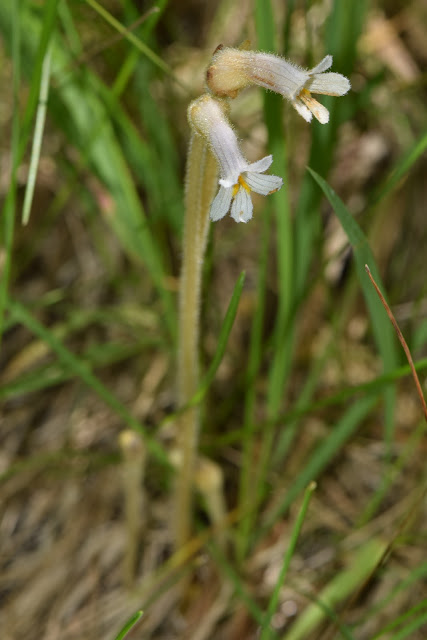I went for a walk with my family in Komoka Provincial Park just outside London, Ontario. I realized looking back that I really didn't take many photos other than probably about 1000 of a patch of orchids we ran into. The day included nice walking through lush green woods, floodplain and grassland/ shrubland habitat. The grassland areas has a lovely array of birds calling including Savannah Sparrows and Meadowlark.
 |
| Savannah Sparrow |
Eastern Meadowlarks are a grassland bird that are a Species at Risk in Ontario. They nest and forage on the ground in farm fields, meadows and grasslands. Meadowlarks are medium sized (like an American Robin) birds with a very identifiable appearance. They have a pal brown blotchy back and a bright yellow throat with a bold black "V" necklace and a sharp pointed beak. Males and females look the same and juveniles look like a duller version of an adult with a less bold necklace. The Eastern Meadowlark looks identical to a Western Meadowlark but the two species do not overlap in range.
 |
| Eastern Meadowlark |
Meadowlarks are insectivores and have experienced population decline associated with loss of habitat from conversion to agriculture and loss of food resources from use of insecticides.
 |
| Eastern Meadowlark |
Tree Swallows are beautiful iridescent blue (male) or greenish-blue (female) birds. They have an entirely white throat and chest which identiies them from some other swallows in Ontario. Like the Eastern Meadowlark this species is insectivorous, but it hasn't experienced declines to the same degree. It nests in cavities in a variety of habitats and often can be found in man-made nest boxes. They are extremely agile fliers and watching them hunt is a quite spectacular display.
 |
| Tree Swallow |
I must admit it was a pretty nice day for wildflowers too! I expect I will bore you with a lot of similar pictures if you don't like plants but these were my favorites of the day:
Wild Geranium (
Geranium maculatum) is a native perennial in Ontario that has beautiful delicate looking flowers. It was such a windy day that these light flowers were getting tossed around easily and it was a bit frustrating to get a photo of.
 |
| Wild Geranium (Geranium maculatum) |
 |
| Wild Geranium (Geranium maculatum) |
Northern Small Yellow Lady's Slipper (Cypripedium parviflorum var. makasin) is of of three varieties of Yellow Lady's-slipper recognized by the smaller sized flower (with the lip ranging from 15-29 mm) and red-purple 'madder' on the staminodium (that downward triangle bit pointing into the slipper) and streaking on the slipper pouch. Lateral petals are narrow, up to 2 inches long, typically spirally twisted, dark purple-brown. The sepals behind the petals are similar in colour.
 |
| Northern Small Yellow Lady's Slipper (Cypripedium parviflorum var. makasin) |
 |
| Northern Small Yellow Lady's Slipper (Cypripedium parviflorum var. makasin) |
 |
| Northern Small Yellow Lady's Slipper (Cypripedium parviflorum var. makasin) |
 |
| Northern Small Yellow Lady's Slipper (Cypripedium parviflorum var. makasin) |
 |
| Northern Small Yellow Lady's Slipper (Cypripedium parviflorum var. makasin) |
Despite the smaller sized flowers, the plant still grows 10-40 cm tall and on the larger plants the large green leaves dwarf the flower.
 |
| Northern Small Yellow Lady's Slipper (Cypripedium parviflorum var. makasin) |
Yellow Lady's-slipper orchids live in a variety of habitats including moist deciduous or mixed forests, bogs, moist fields and prairies. The conditions the plant grows in can affect size, bloom time and colour.
 |
| Northern Small Yellow Lady's Slipper (Cypripedium parviflorum var. makasin) |
 |
| Northern Small Yellow Lady's Slipper (Cypripedium parviflorum var. makasin) |
 |
| Northern Small Yellow Lady's Slipper (Cypripedium parviflorum var. makasin) |
Lady's-slipper orchids actually offer no reward to pollinators, which visit flowers for pollen or nectar. They use their bright colour and somewhat depend on co-flowering species to attract pollinators so they can deceive insects into pollinating. Insects such as small bees and flies enter the slipper and get forced to exit through one of two channels behind the staminodium. When they squeeze their way through the tunnel a pollen mass is deposited on their back. When they visit the next flower this is removed when they squeeze through.
 |
| Northern Small Yellow Lady's Slipper (Cypripedium parviflorum var. makasin) |
 |
| Northern Small Yellow Lady's Slipper (Cypripedium parviflorum var. makasin) |
One-flowered Cancer-Root (Orobanche uniflorum) is a parasitic plant native to North America. Parasitic plants produce no chlorophyll of their own and need to feed off the roots of other plants. According to Michigan Flora, this species attaches to and feed off of members of Asteraceae.
 |
| One-flowered Cancer-Root (Orobanche uniflorum) |
This species can be found in a variety of habitats including woods, thickets and riverside. I found this one in a floodplain area in full sun.
 |
| One-flowered Cancer-Root (Orobanche uniflorum) |
 |
| One-flowered Cancer-Root (Orobanche uniflorum) |
 |
| One-flowered Cancer-Root (Orobanche uniflorum) |
Canada Wild Ginger (
Asarum canadense) is a short plant with velvety heart-shaped leaves. In between the two leaf stalks is a redish- brown flower grows out at ground level. These flowers are a bit inconspicuous but I find them very cute. This species can grow in large colonies and form a mat on the forest floor.
 |
| Canada Wild Ginger (Asarum canadense) |






















No comments:
Post a Comment